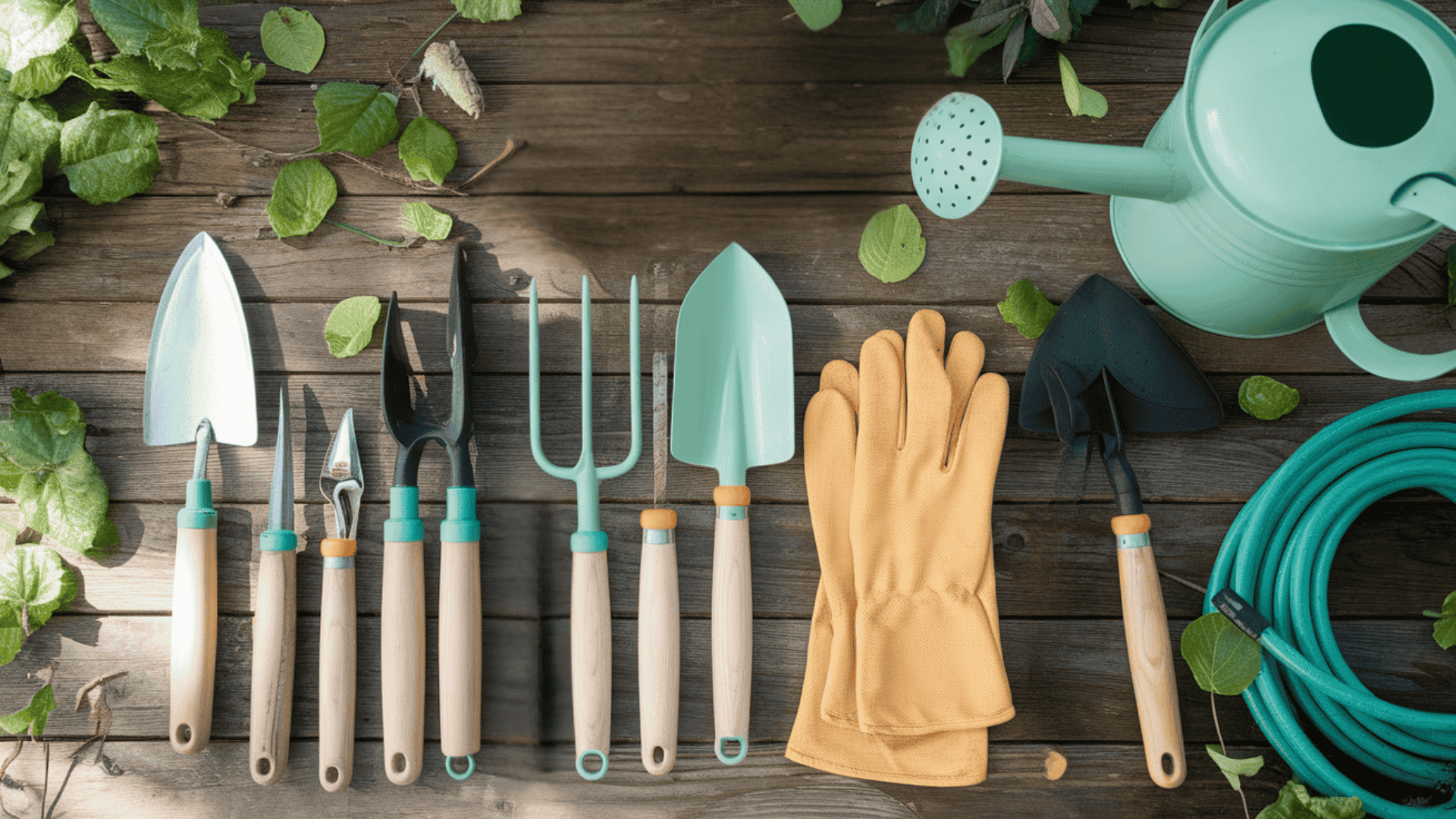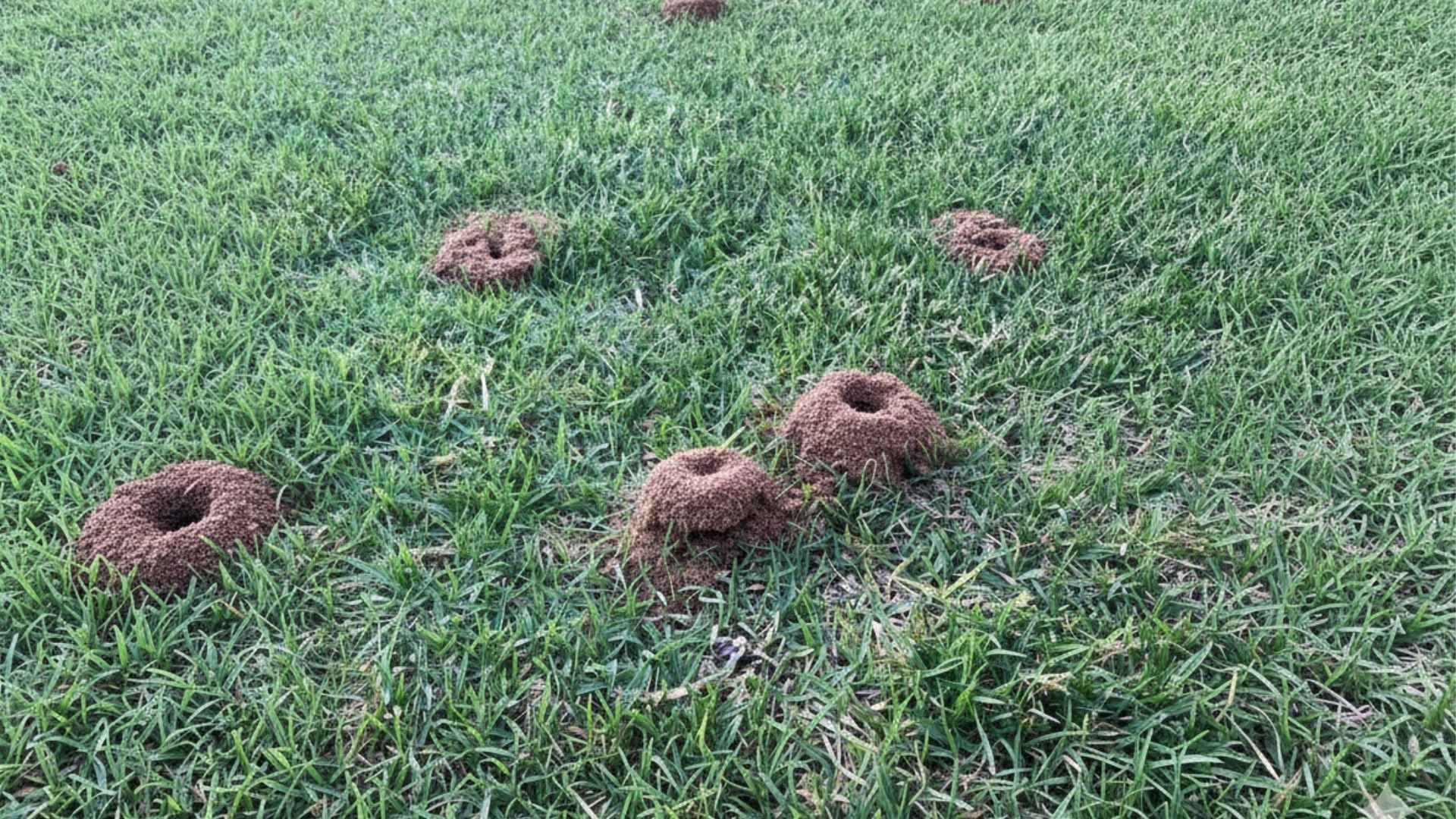Every successful garden starts with the right tools in your hands.
Most gardening struggles occur not because of a lack of plant knowledge, but because people use inappropriate equipment that fails to meet their specific needs.
Quality tools save time, protect plants from damage, and reduce the physical strain that keeps many from enjoying their outdoor spaces.
With hundreds of garden gadgets available, knowing which ones actually matter makes the difference between a thriving garden and constant frustration.
This comprehensive guide covers essential gardening tools, explaining exactly when and how to use each one. Use this as a reference when choosing garden tools for everyday tasks.
You’ll learn practical applications for every tool category, make informed buying decisions based on your garden size and soil type, and receive maintenance tips that extend tool life for years of reliable service.
Why Gardening Tools Matter?
Think of gardening tools as your trusted companions in creating the garden of your dreams.
The right equipment changes what could be back-breaking work into smooth, enjoyable tasks that save you hours of effort.
When you use proper tools, your plants stay healthier because you’re less likely to accidentally damage roots or stems during care routines.
Quality tools with comfortable grips and smart designs mean less strain on your hands, back, and knees, allowing you to garden longer without aches and pains.
Most importantly, having the right tool for each job means you can manage your entire garden more effectively, from quick weeding sessions to major soil preparation projects.
45 Gardening Tools with Names and Functions
Learn 45 essential gardening tools with their names and functions, from hand trowels to watering cans, to make gardening easier, efficient, and more enjoyable.
1. Trowel
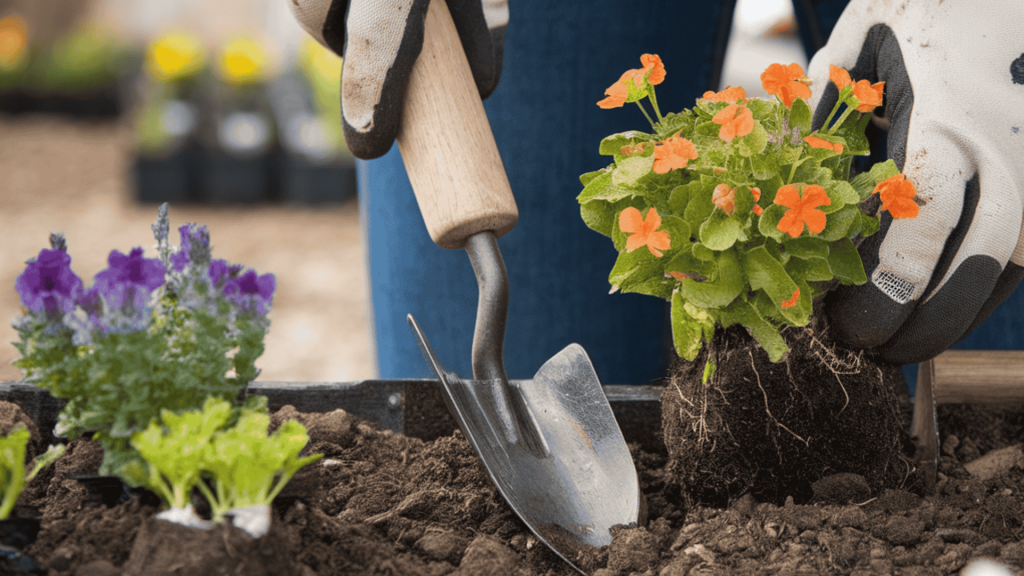
Your most versatile hand tool, featuring a curved, pointed blade that is perfect for digging small holes and scooping soil.
The narrow design allows precise work in tight spaces between plants. Essential for creating planting holes that match root ball sizes exactly.
When to use: Transplanting seedlings, planting bulbs, container gardening, and working in established flower beds.
2. Hand Fork
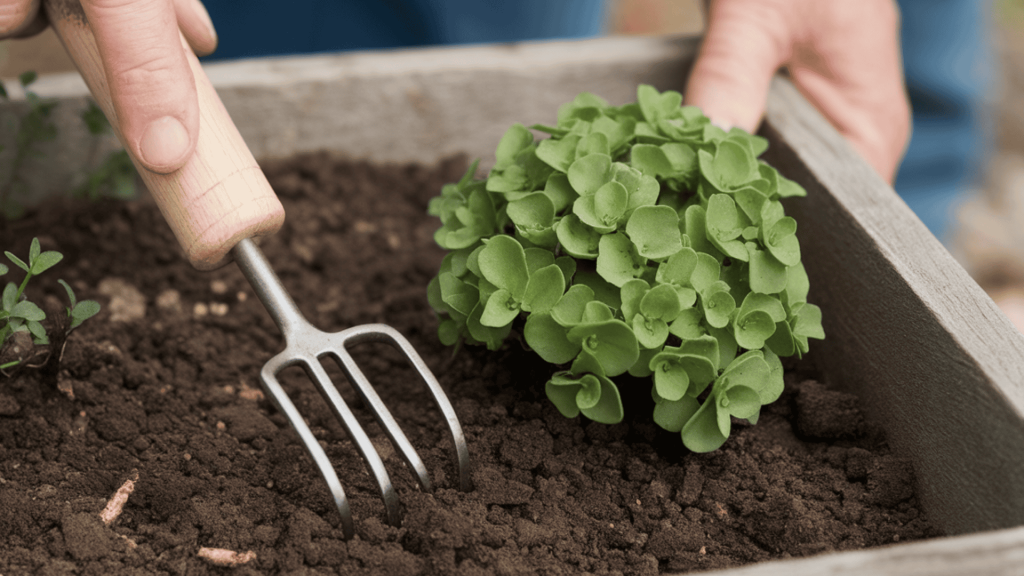
A miniature version of a garden fork with 3-4 short tines designed to penetrate compacted soil without disturbing nearby plant roots.
The small size gives you control when working around delicate plants. Perfect for breaking up surface crusts that prevent water absorption.
When to use: Aerate soil around existing plants, work compost into small areas, and loosen dirt in containers.
3. Pruners (Secateurs)
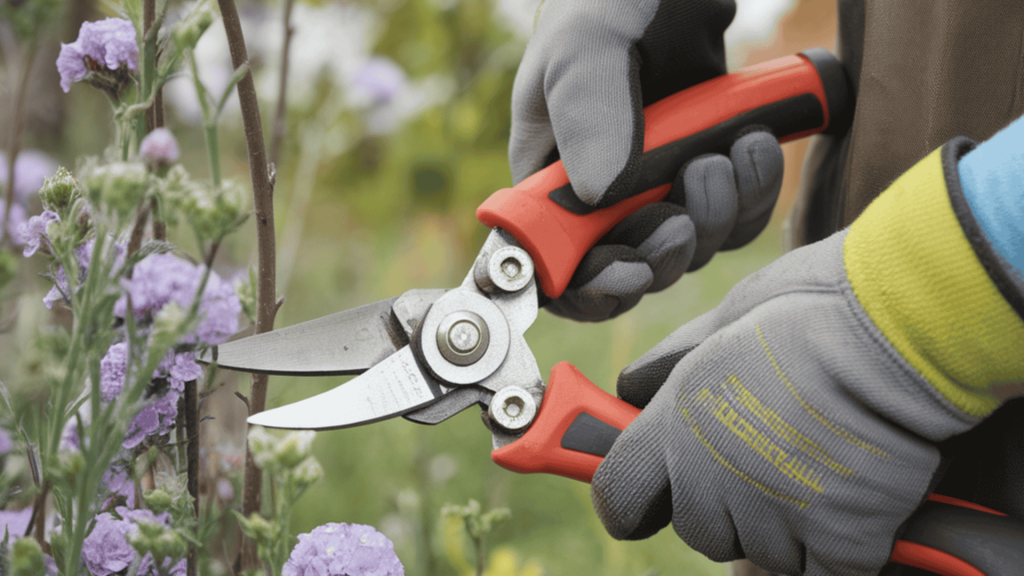
Sharp bypass or anvil blades that make clean cuts through stems up to ¾ inch in diameter. Quality pruners reduce hand fatigue and create cuts that heal quickly, preventing disease entry. The spring-loaded action makes repetitive cutting easier on your hands.
When to use: Deadheading flowers, harvesting vegetables, pruning small branches, and cutting back perennials.
4. Weeder
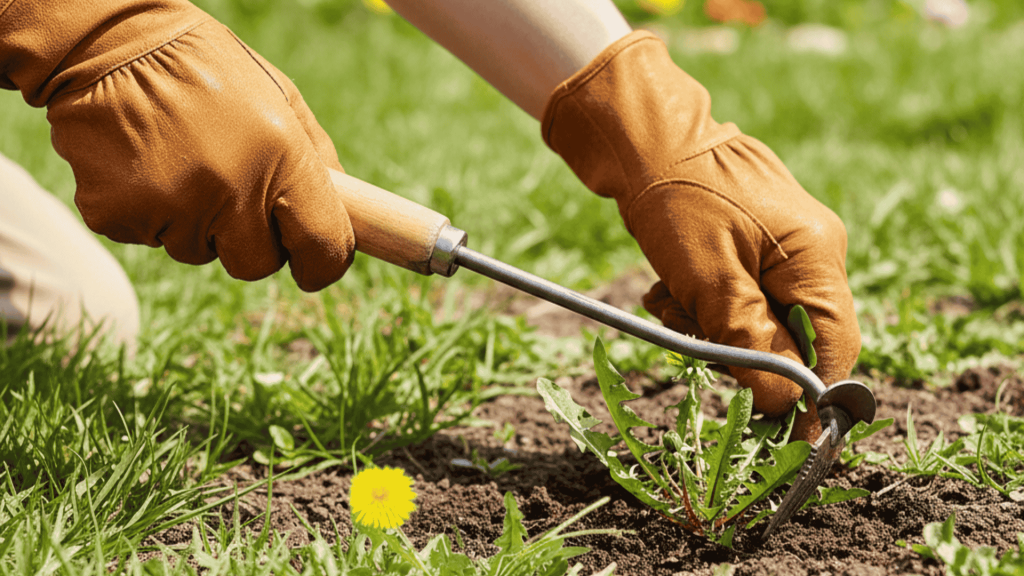
Features a long, narrow blade with a forked or notched tip specifically designed to extract entire weed root systems.
The leverage design lets you pop out deep-rooted weeds without bending over. Some models include a serrated edge for cutting through tough roots.
When to use: Removing dandelions, thistles, and other tap-rooted weeds from lawns and garden beds.
5. Gloves
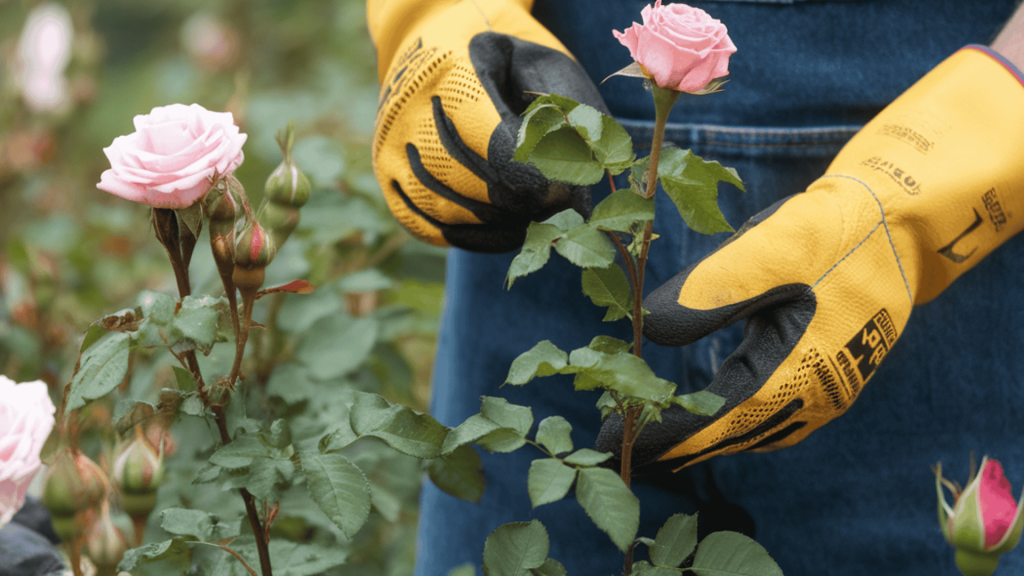
Protective barrier between your hands and thorns, chemicals, and rough surfaces while maintaining dexterity for detailed tasks.
Quality gloves breathe well to prevent sweaty hands and feature reinforced palms for durability. Choose different weights for different seasons and tasks.
When to use:All gardening activities, especially when handling roses, working with fertilizers, or doing heavy digging.
6. Hand Rake
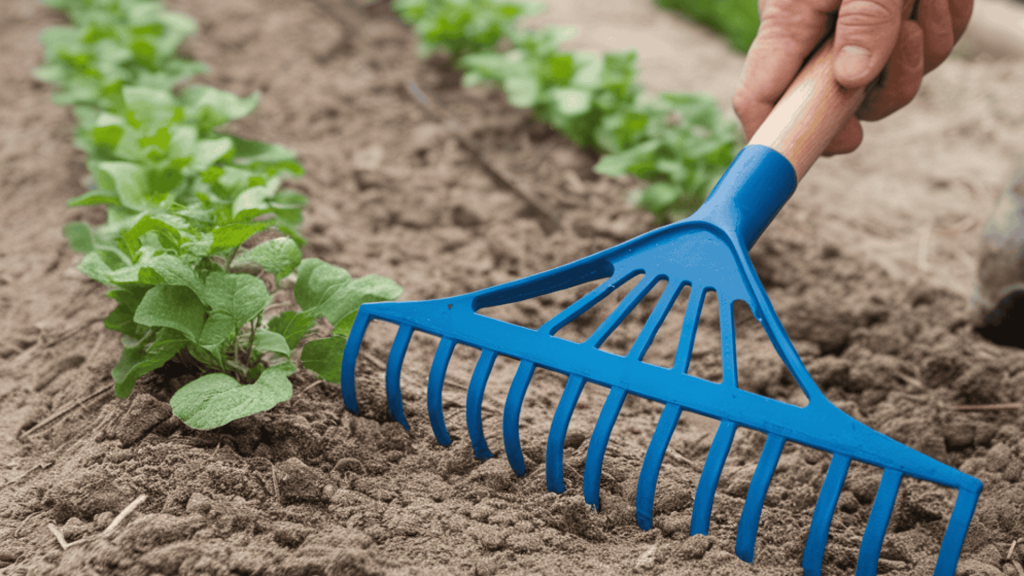
Scaled-down version of a regular rake with short tines, perfect for detailed cleanup work around plants.
The compact size allows gentle raking without damaging shallow roots or small plants. Creates smooth soil surfaces for seed sowing.
When to use: Cleaning up small debris, smoothing soil in seed beds, and maintaining areas between closely spaced plants.
7. Garden Knife
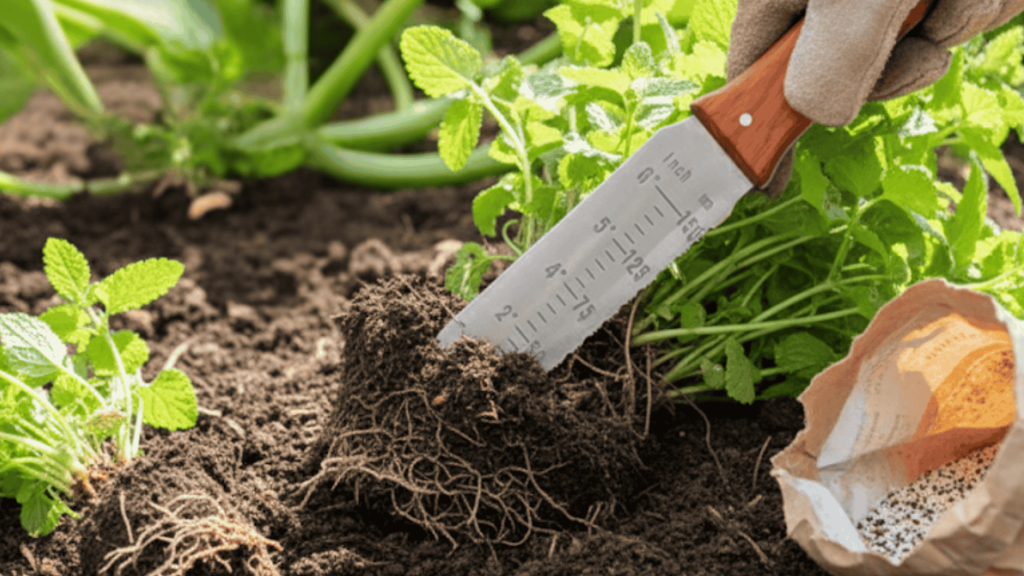
Multi-purpose cutting tool with a sharp, straight blade and often a serrated edge for tough materials.
The sturdy construction handles heavy cutting tasks, while the pointed tip works for detailed jobs. Many feature rulers marked on the blade for measuring.
When to use:Harvesting vegetables, cutting twine, dividing perennial clumps, and opening bags of soil or fertilizer.
8. Spade
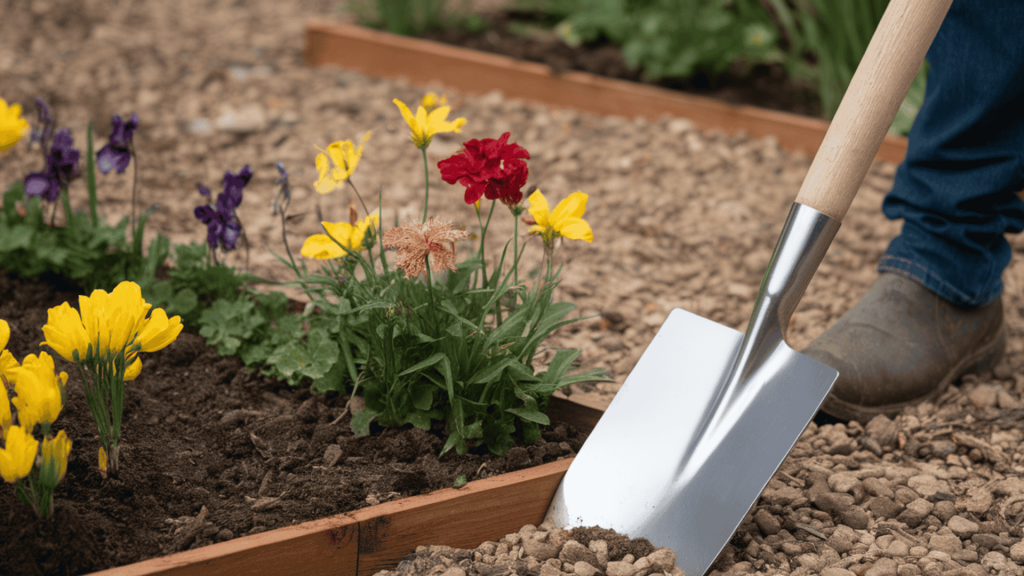
Features a flat, rectangular blade designed for cutting clean lines and digging precise holes. The sharp edge slices through soil and roots more efficiently than curved shovels. The flat blade creates straight edges for beds and walkways.
When to use: Edging flower beds, digging planting holes, cutting through sod, and creating clean garden boundaries.
9. Shovel
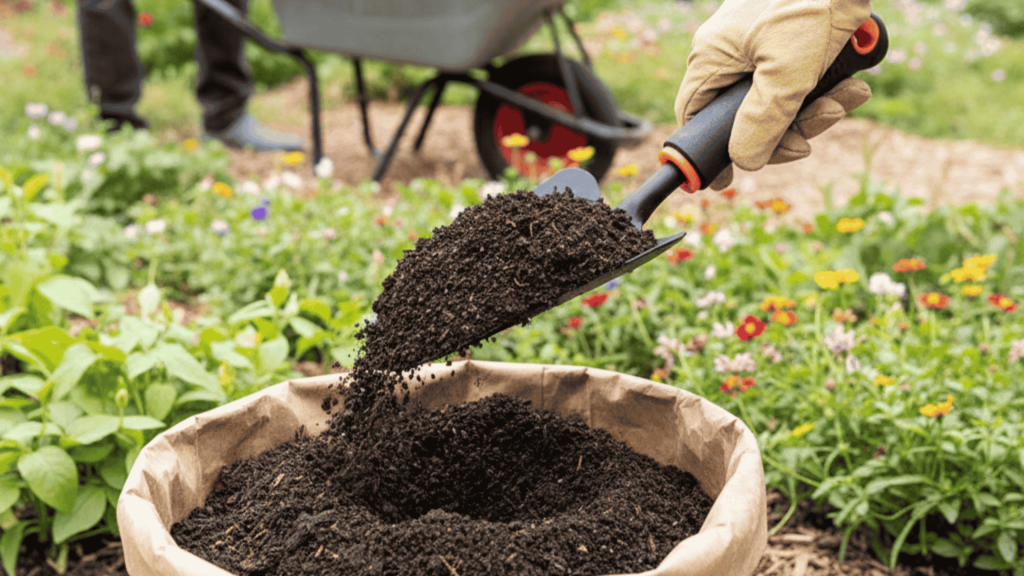
Curved or pointed blade designed for moving loose materials rather than precise digging. The scoop shape holds more material than a spade, making loading and unloading faster and more efficient. Different point styles are more effective for different soil types.
When to use:Moving compost, loading wheelbarrows, digging in loose soil, and general material handling.
10. Hoe
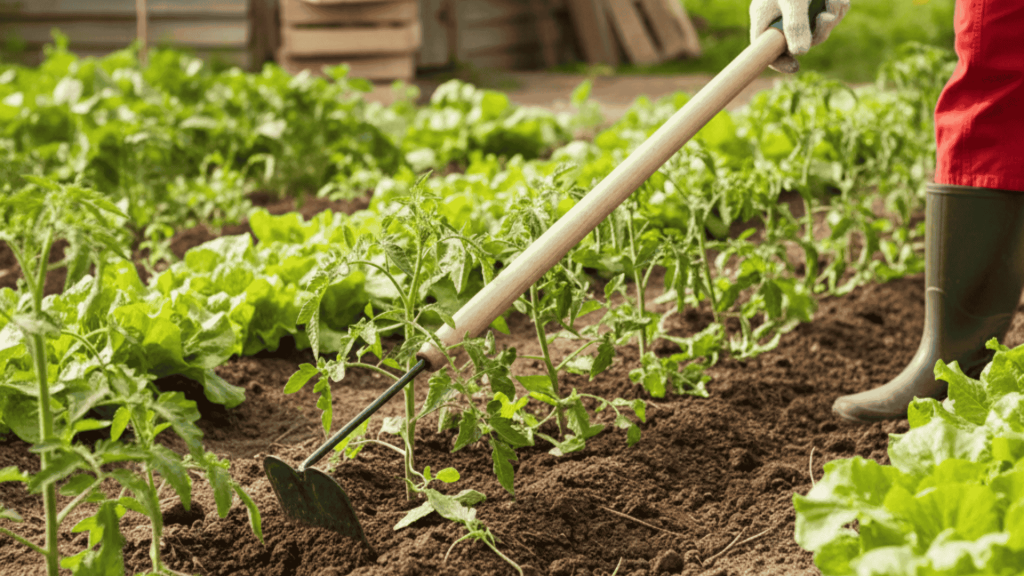
Flat blade attached at an angle to a long handle for chopping weeds and breaking the soil surface.
The sharp edge cuts weed stems at ground level, where they can’t regrow. Works by pushing and pulling motions to break up compacted surface soil.
When to use: Weeding between crop rows, breaking up crusty soil, creating shallow furrows for seeds.
11. Garden Fork (Pitchfork)
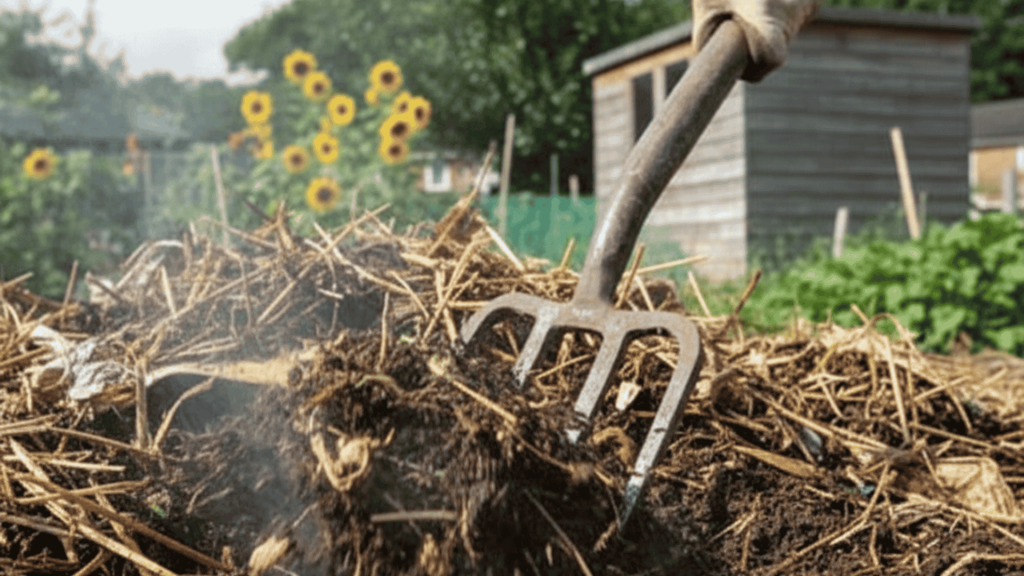
Four sturdy tines penetrate soil without creating the compaction that solid blades can cause. The tines lift and turn materials while allowing air to flow through.
Heavy-duty construction handles tough jobs, such as moving hay or compost.
When to use: Turning compost piles, aerating compacted soil, lifting root vegetables, and moving organic matter.
12. Mattock
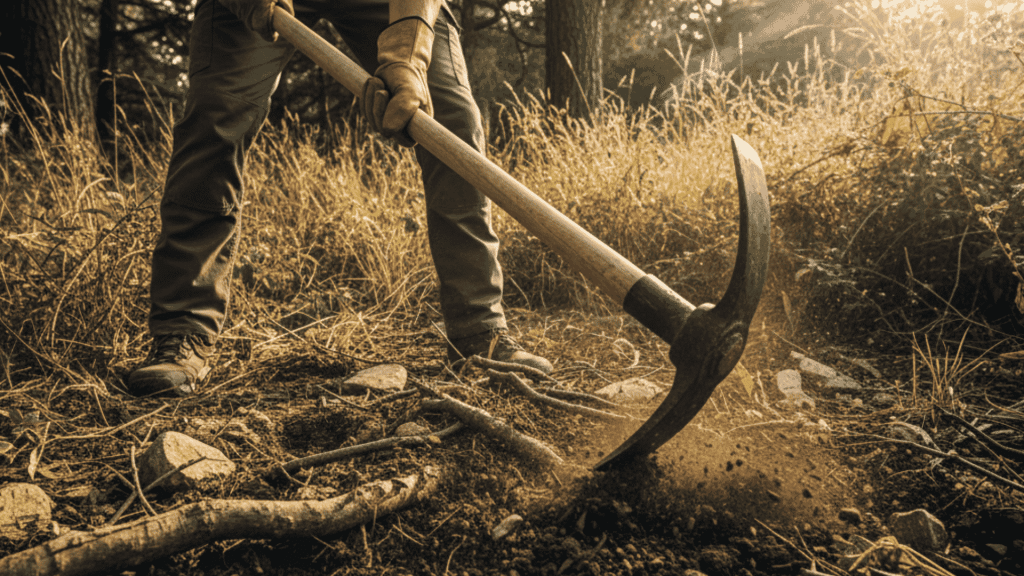
Heavy-duty tool combining an axe blade and a wide cutting blade for the toughest ground-breaking jobs.
The weight and leverage handle roots and rocky soil that other tools can’t manage. Professional landscapers rely on mattocks for challenging terrain.
When to use:Breaking new ground, removing large roots, working in rocky soil, and clearing overgrown areas.
13. Watering Can
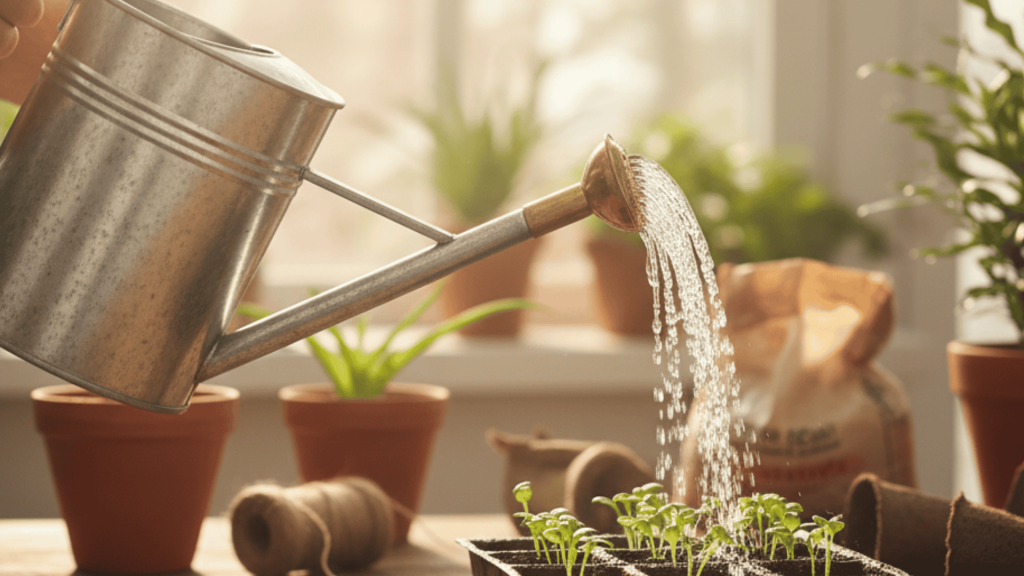
Provides precise water control with a removable rose (sprinkler head) that creates gentle rain-like drops.
The long spout easily reaches into containers and hanging baskets. Various sizes handle different watering needs from seedlings to large containers.
When to use: Watering seedlings, container plants, and houseplants, as well as applying liquid fertilizers to specific plants.
14. Garden Hose
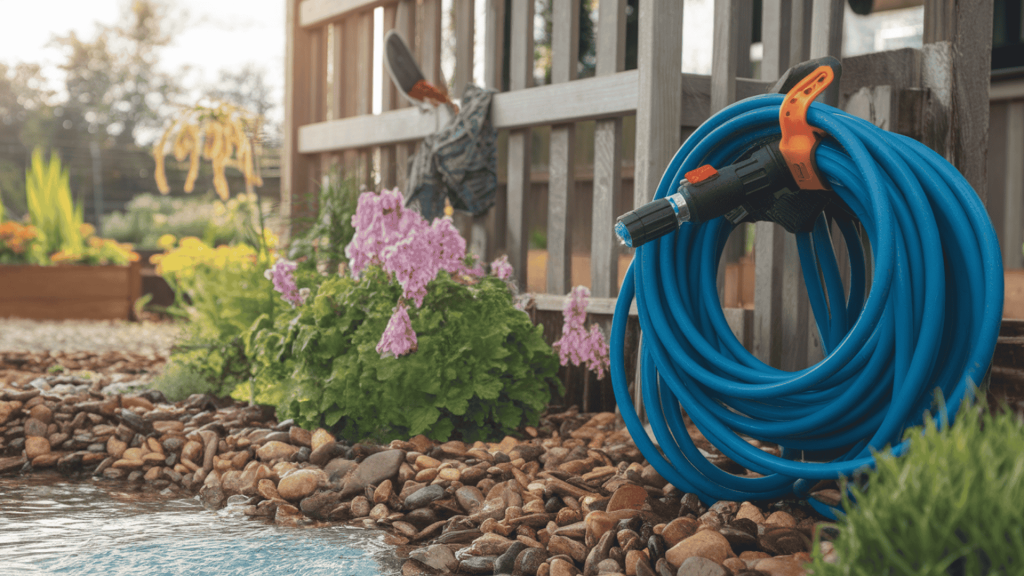
Flexible water delivery system available in various lengths and diameters for different flow rates.
Quality hoses resist kinking and splitting while remaining flexible in cold weather. Proper storage extends hose life significantly.
When to use: Watering large areas, filling pools or containers, cleaning tools and surfaces, and reaching distant garden areas.
15. Sprinkler
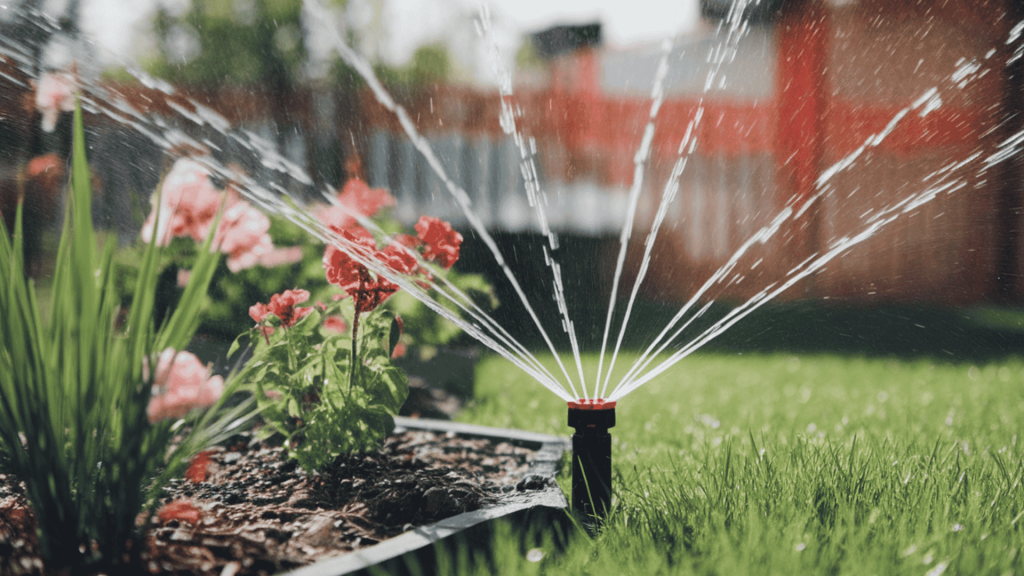
An automated watering device that distributes water evenly over large areas without your constant attention.
Different patterns (oscillating, rotary, and stationary) suit different garden shapes. Timer controls prevent overwatering and water waste.
When to use: Watering lawns, covering large garden beds, and maintaining consistent moisture during hot weather.
16. Soaker Hose
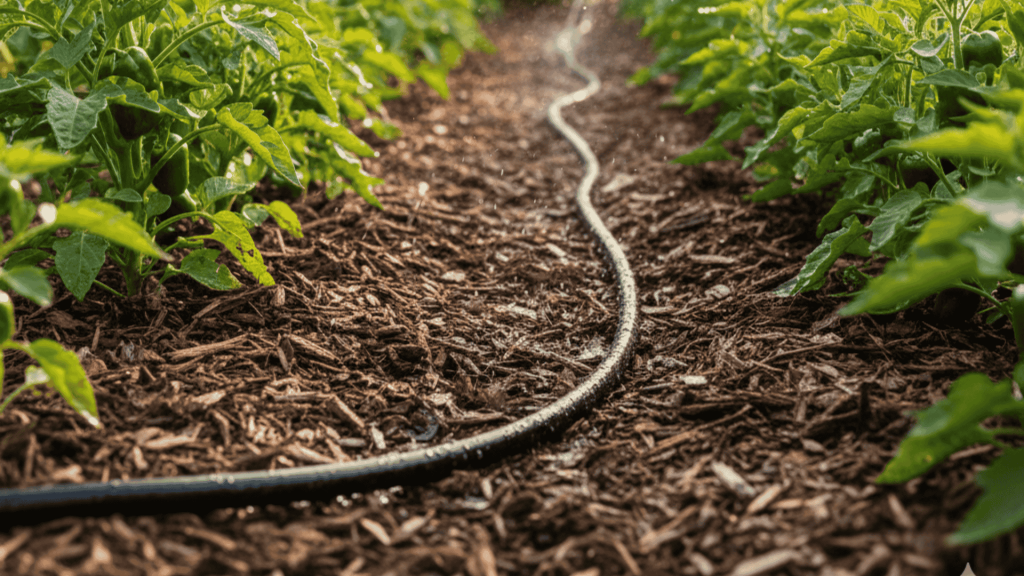
Porous hose that slowly releases water directly to plant roots, reducing evaporation and keeping foliage dry. The low-pressure system works well on slopes and uneven terrain.
Covering with mulch hides the hose and further reduces evaporation.
When to use: Deep watering of trees and shrubs, vegetable gardens, and areas where overhead watering might cause disease.
17. Water Wand
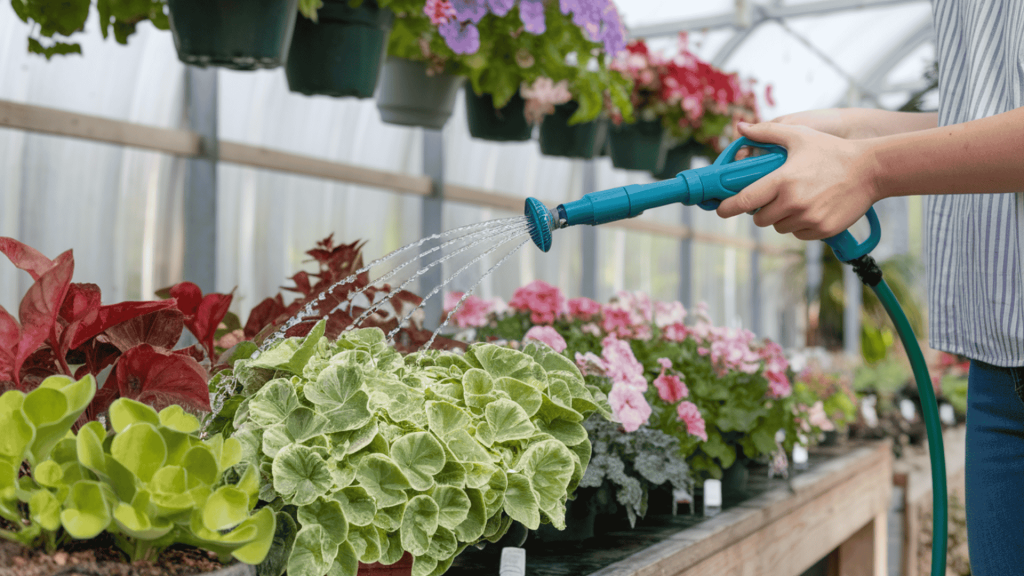
Extension handle with a spray head that provides gentle, rain-like water patterns for delicate plants. The long reach eliminates the need for stretching and bending while watering.
Multiple spray settings cater to the diverse needs of various plants.
When to use:Watering hanging baskets, tall plants, greenhouse benches, and other areas that require gentle water application.
18. Loppers
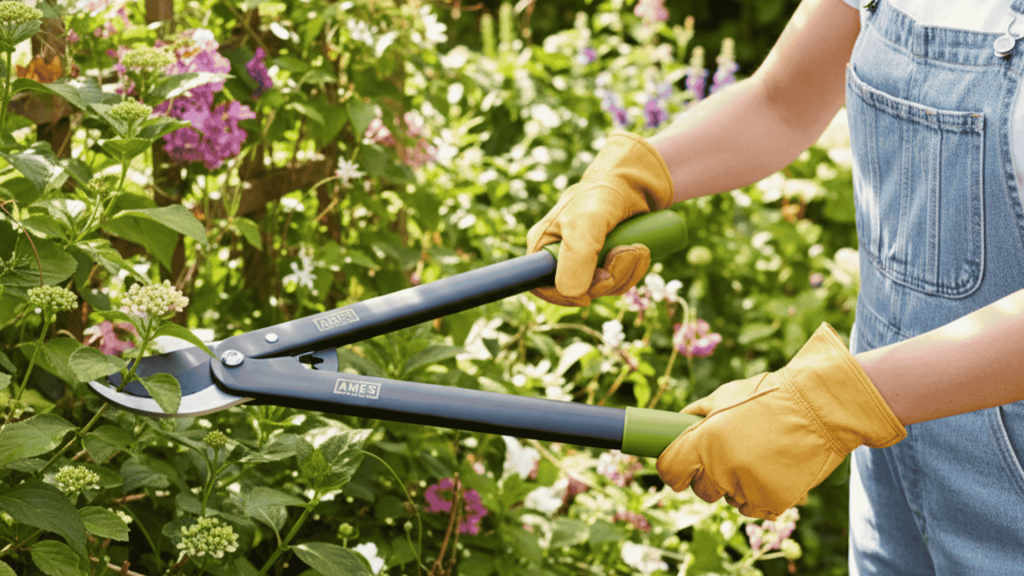
A long-handled pruning tool that uses leverage to cut branches 1-2 inches thick with less effort than hand pruners.
The extended reach handles high branches safely from the ground. Anvil or bypass blade designs suit different cutting needs.
When to use: Pruning fruit trees, removing dead branches, cutting back overgrown shrubs, and general tree maintenance.
19. Hedge Shears
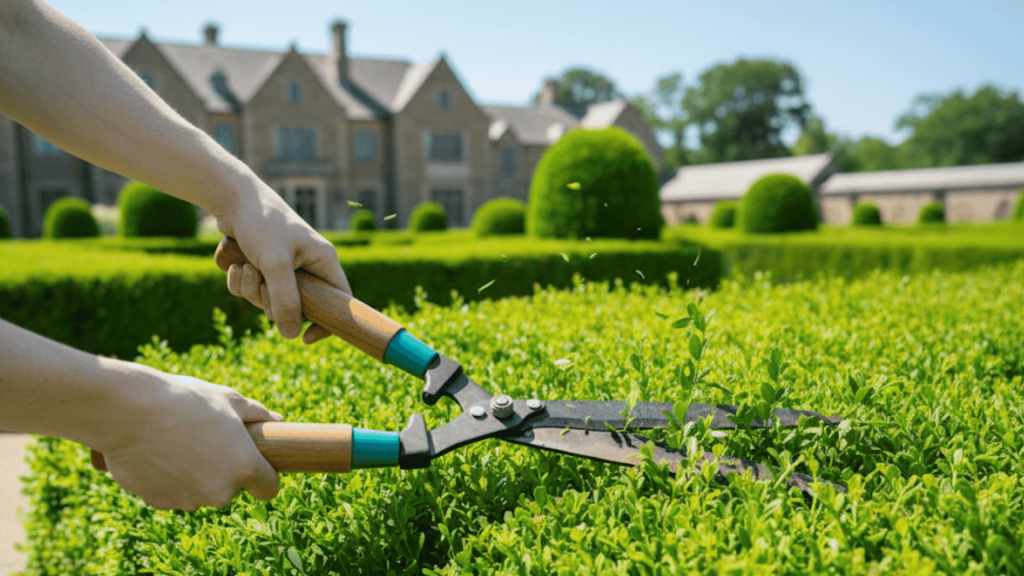
Long, straight blades designed to cut multiple small branches simultaneously for shaping hedges and topiaries.
The long handles provide leverage for extended cutting sessions. Sharp blades ensure clean cuts that heal properly.
When to use:Trimming formal hedges, shaping topiaries, cutting back ornamental grasses, and maintaining dense shrubs.
20. Pruning Saw
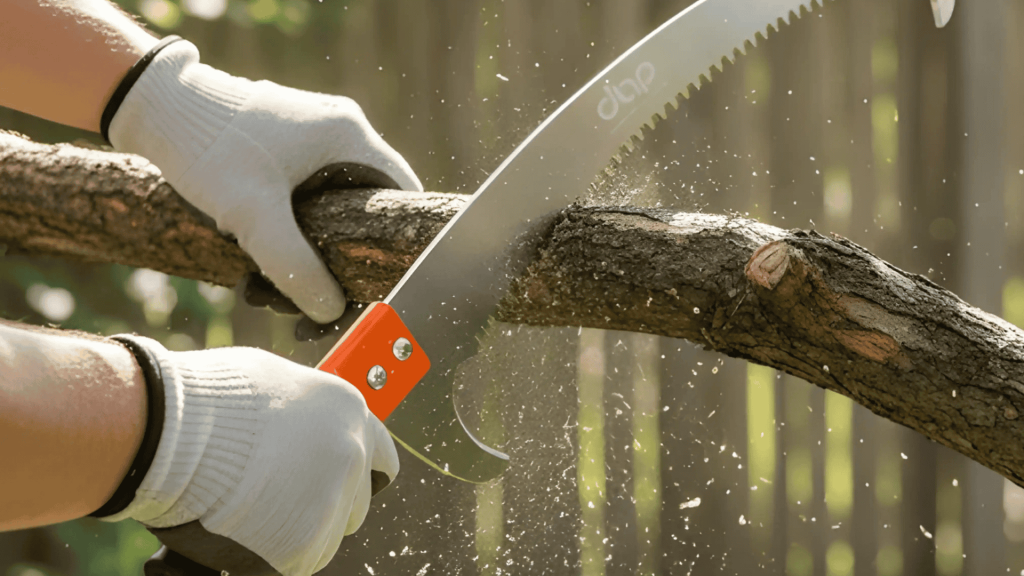
Curved blade with aggressive teeth designed to cut branches too thick for loppers. The curved design follows natural cutting motion, while the sharp teeth cut on both push and pull strokes.
Folding models store safely and compactly.
When to use: Removing large branches, cutting firewood, clearing storm damage, and major tree pruning projects.
21. Grass Shears
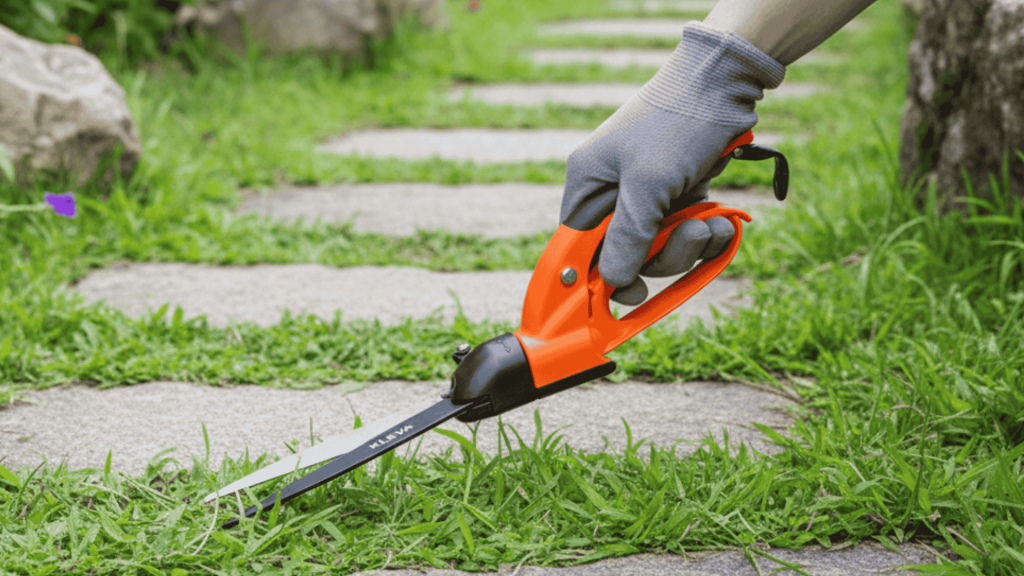
Long-handled scissors designed specifically for cutting grass in areas where mowers can’t reach.
The extended handles eliminate bending and kneeling while providing precise control. Some models feature rotating heads for easier cutting angles.
When to use: Trimming grass edges along sidewalks, around trees, near fences, and in tight corners.
22. Grafting Knife
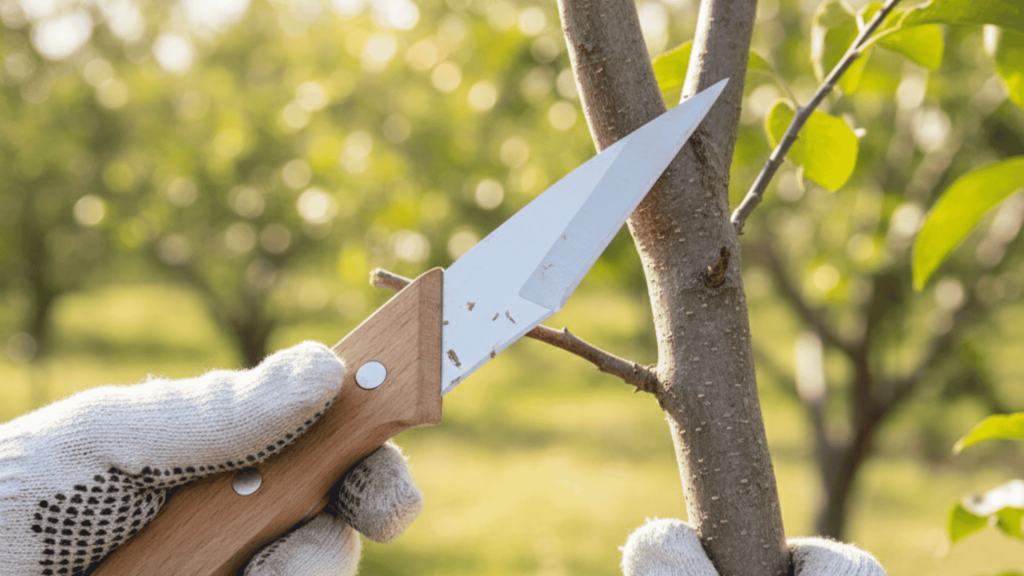
Extremely sharp, thin blade designed to make precise, clean cuts essential for successful plant grafting.
The razor-sharp edge creates smooth surfaces that heal together properly. The folding design protects both the blade and the user when the knife is not in use.
When to use: Grafting fruit trees, propagating roses, creating specialty plant combinations, and advanced plant breeding work.
23. Wheelbarrow
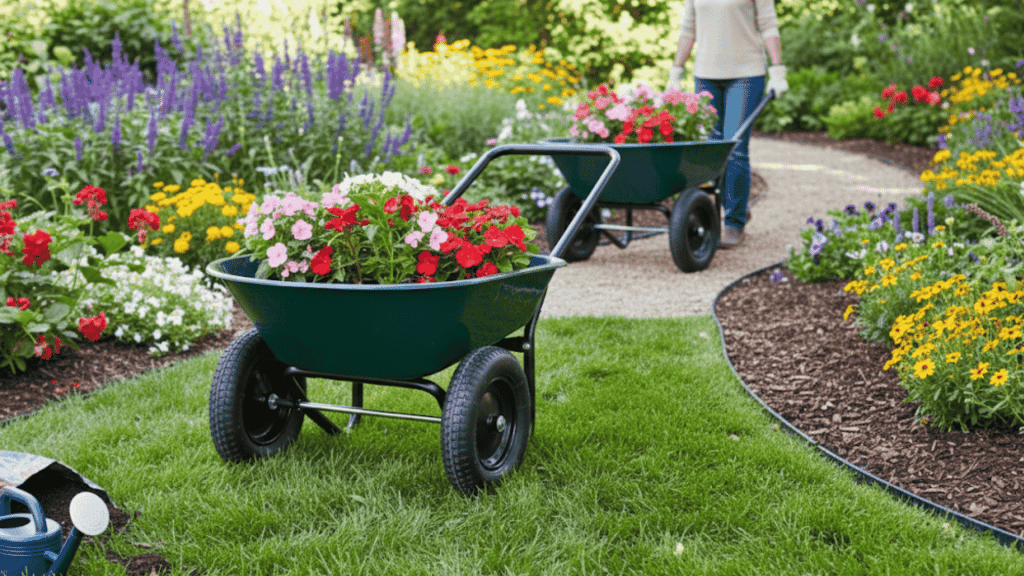
Single-wheeled cart designed for easy maneuvering through narrow garden paths while carrying heavy loads.
The front wheel pivots for tight turns while the handles provide leverage for lifting. Deep tray holds more material than it appears.
When to use: Moving soil, compost, plants, and tools around the garden, especially in areas with narrow access.
24. Garden Cart
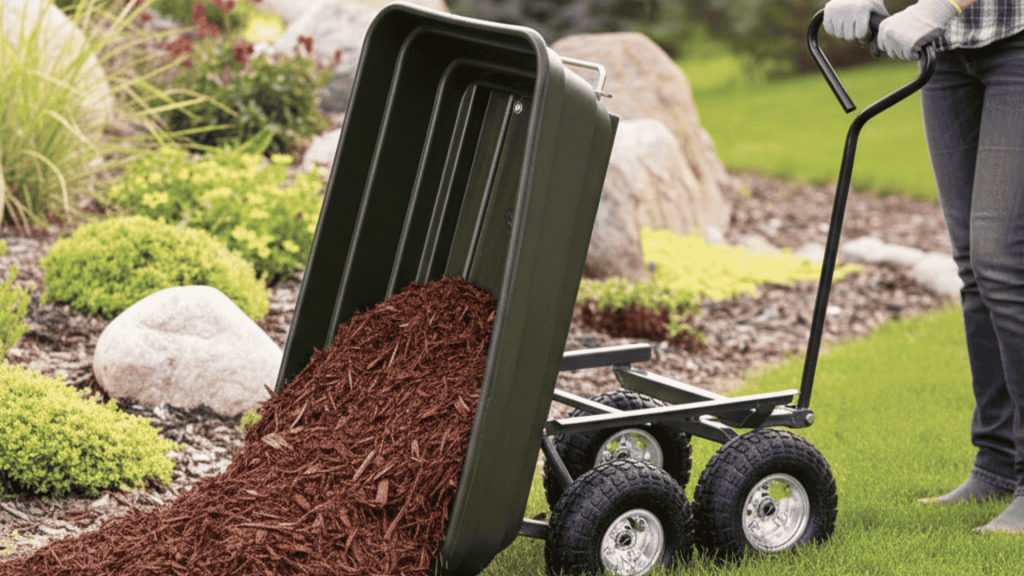
A two or four-wheeled cart that provides stability for heavier loads than wheelbarrows can handle. The multiple wheels distribute weight evenly and won’t sink into soft ground.
The dump feature makes unloading easier.
When to use:Hauling rocks, large plants, multiple bags of materials, and when stability is more important than maneuverability.
25. Soil Scoop
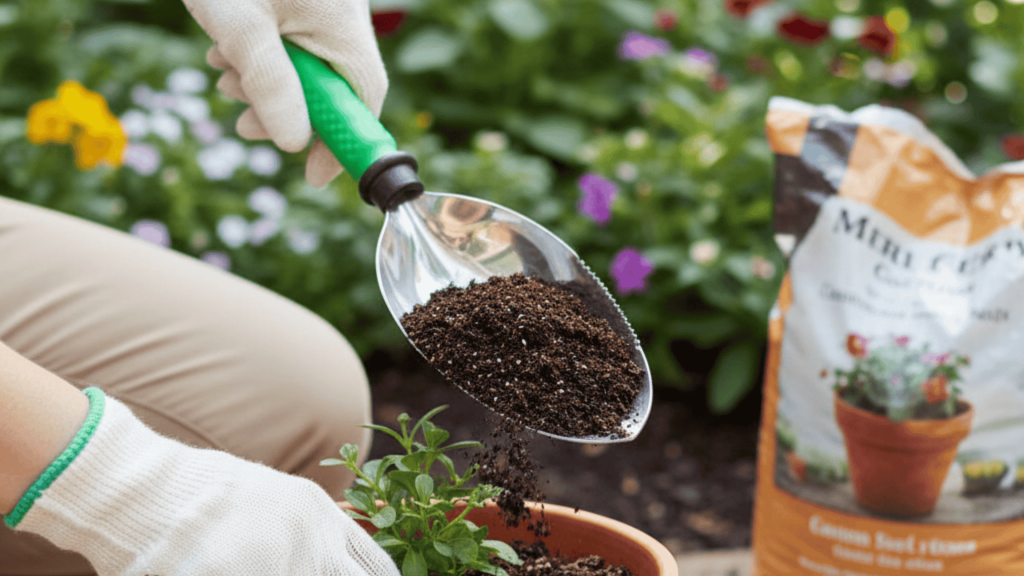
Deep, curved blade designed for transferring loose materials like potting mix, fertilizer, and mulch without spilling.
The comfortable handle reduces hand strain during repetitive scooping. Various sizes handle different volume needs.
When to use: Filling containers with potting mix, transferring compost, applying mulch, and measuring granular fertilizers.
26. Compost Aerator
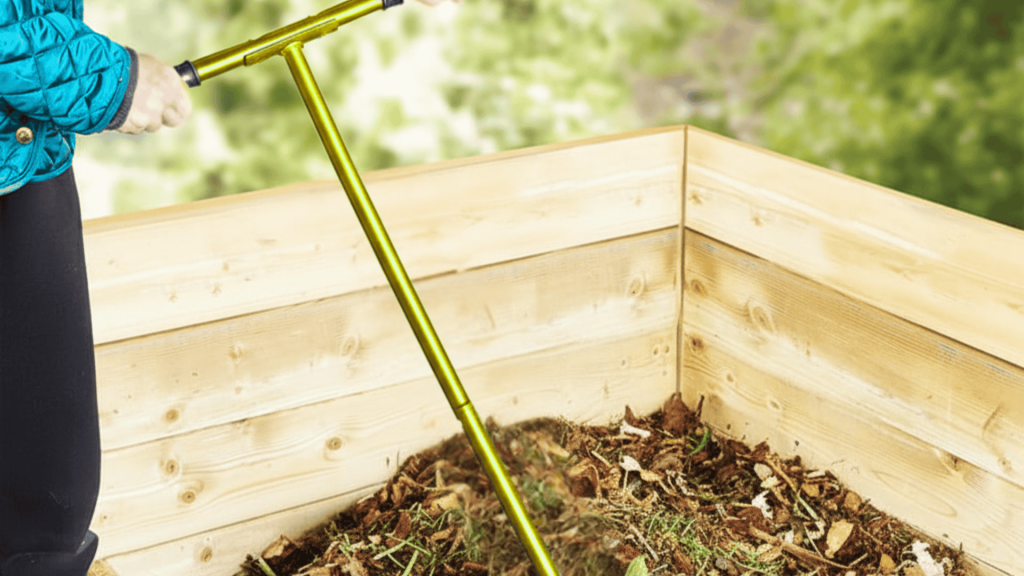
Twisted metal shaft that creates air channels in compost piles to speed decomposition. The corkscrew design breaks up compacted material while the pointed end penetrates dense piles easily.
Regular aeration produces finished compost faster.
When to use:Mixing compost piles, adding oxygen to slow-decomposing material, and breaking up matted organic matter.
27. Measuring Scoop
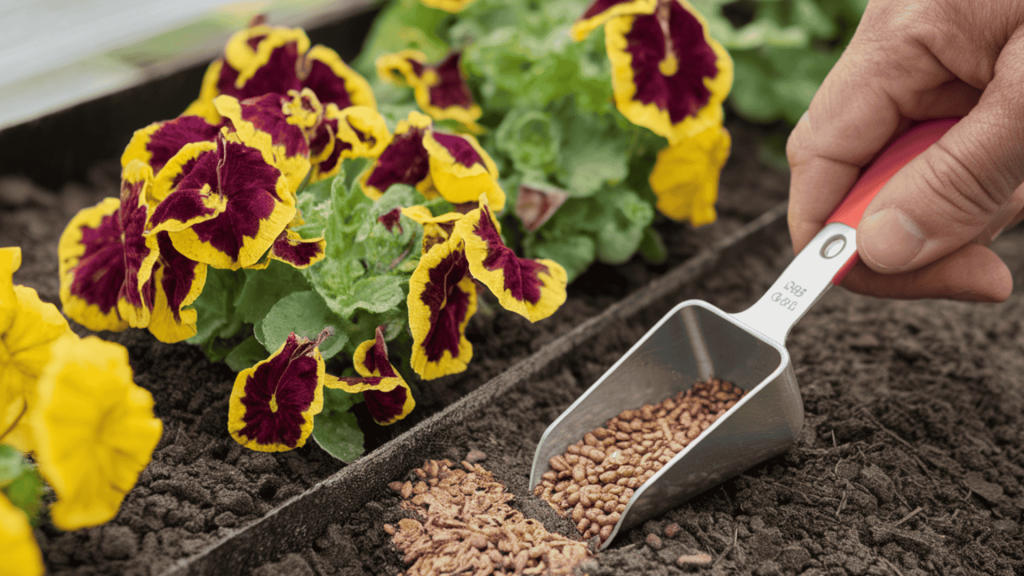
Calibrated container that ensures accurate application rates for fertilizers, seeds, and soil amendments.
Prevents costly over-application while ensuring plants get adequate nutrition. Different sizes handle various application rates.
When to use: Applying granular fertilizers, measuring seeds for sowing, and mixing soil amendments in correct proportions.
28. Lawn Mower
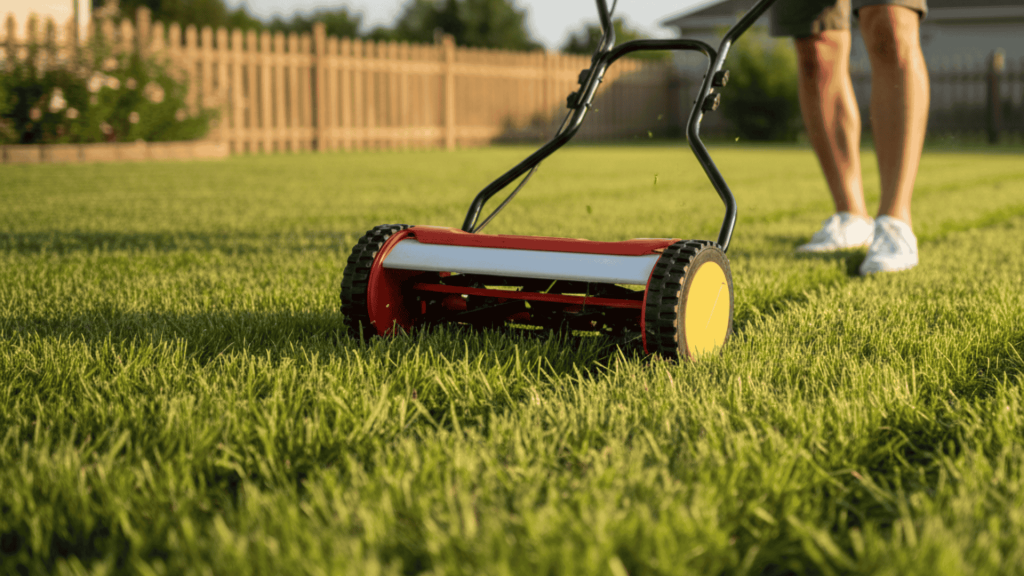
A Mechanical cutting device that maintains grass at the proper height for healthy growth and an attractive appearance.
Regular cutting encourages thick growth that naturally crowds out weeds. Different cutting heights suit various grass types and seasons.
When to use:Weekly grass cutting during the growing season, maintaining sports areas, and keeping lawns neat and healthy.
29. Grass Rake
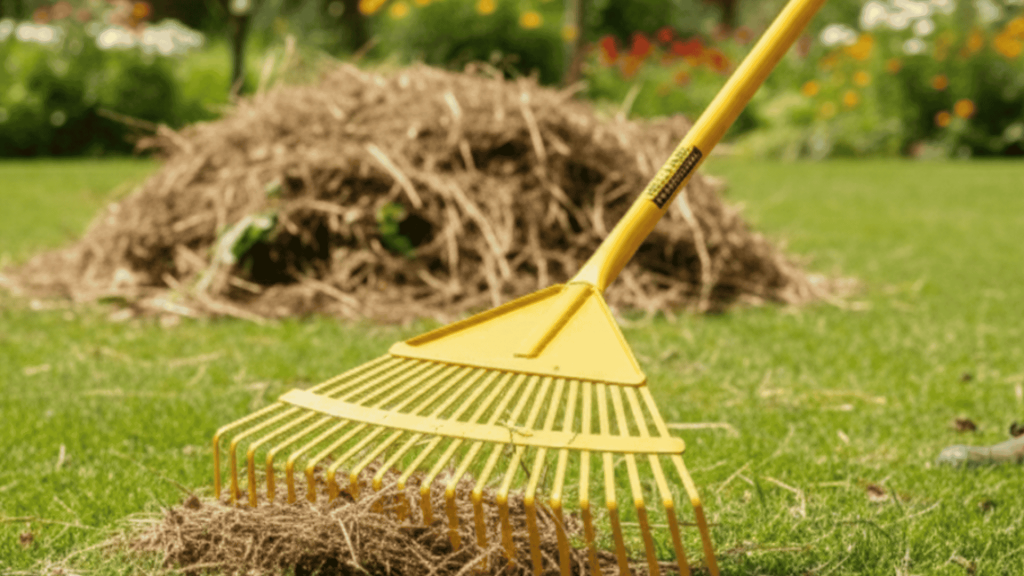
Flexible tines that gather light debris without damaging grass or soil surface. The spring action allows tines to bend around obstacles and return to their original shape.
Wide head covers more area with each stroke.
When to use:Collecting grass clippings, gathering fallen leaves, removing light debris, and preparing seed beds.
30. Edger
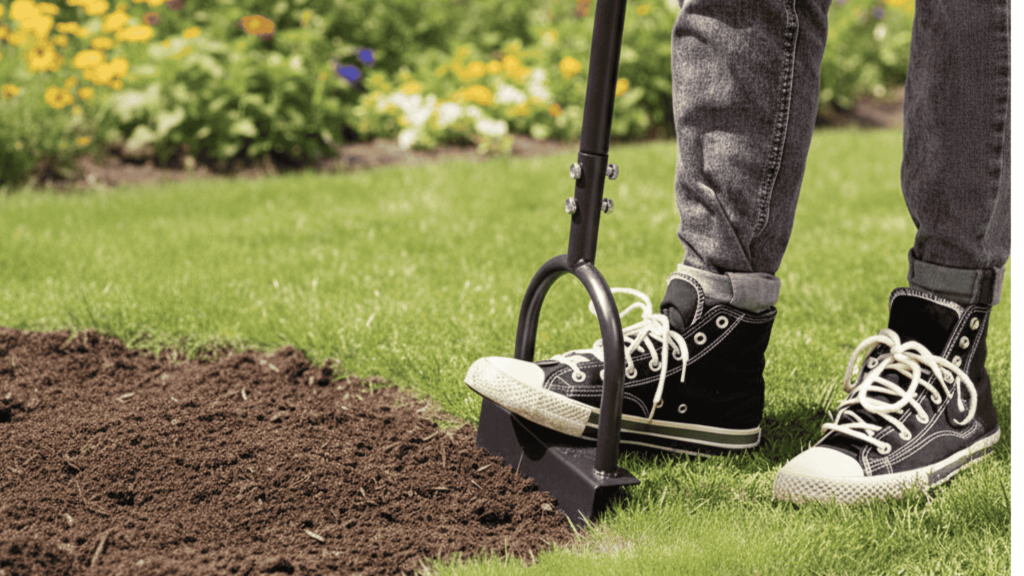
Sharp blade that cuts clean lines between different garden areas for professional-looking boundaries.
Creates a permanent separation that reduces maintenance and clearly defines garden spaces. Both manual and powered versions are available.
When to use:Defining bed edges, separating lawn from walkways, creating clean lines around driveways, and maintaining garden organization.
31. Leaf Blower
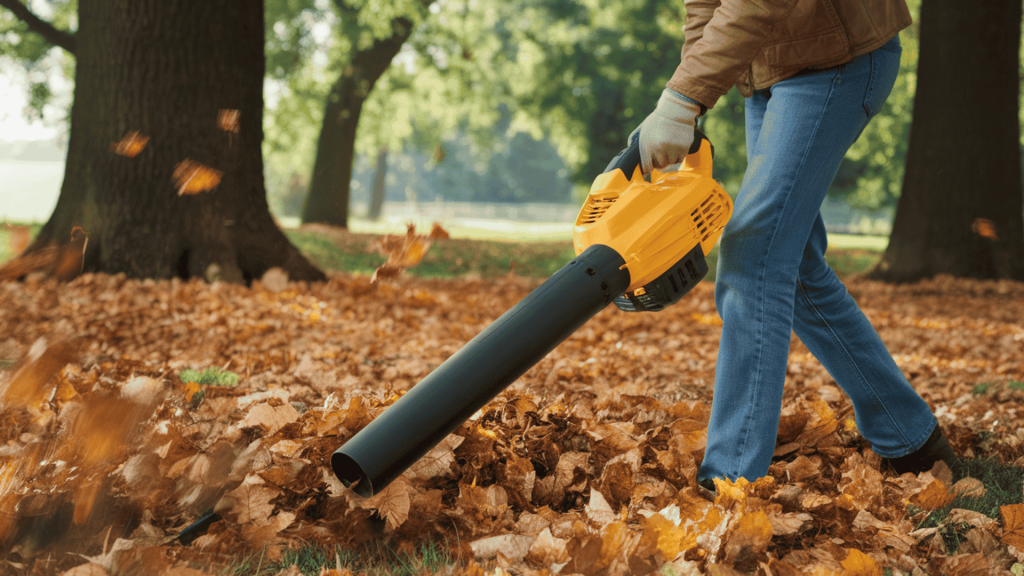
Powerful air stream that moves leaves and debris quickly across large areas.
Electric or gas-powered options suit different property sizes and noise requirements. Variable-speed controls handle a variety of materials and situations.
When to use:Fall leaf cleanup, clearing patios and walkways, removing debris from flower beds, and preparing areas for maintenance.
32. Dethatcher
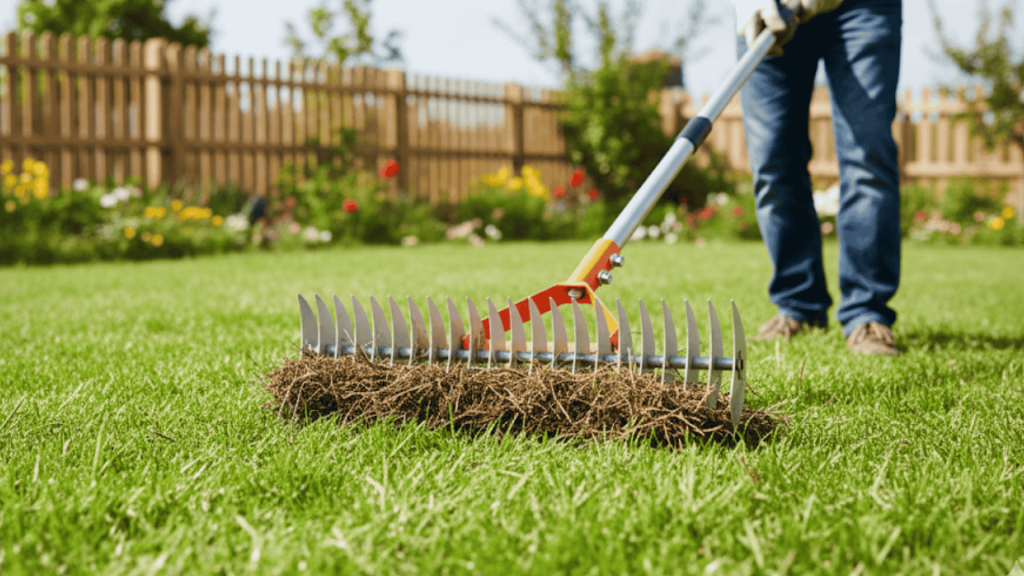
Specialized rake with sharp tines that remove dead grass buildup (thatch) that prevents water and nutrients from reaching roots. The aggressive tines pull up dead material while leaving healthy grass intact.
When to use: Spring and fall lawn renovation, preparing lawns for overseeding, and improving water penetration in established lawns.
33. Seed Tray
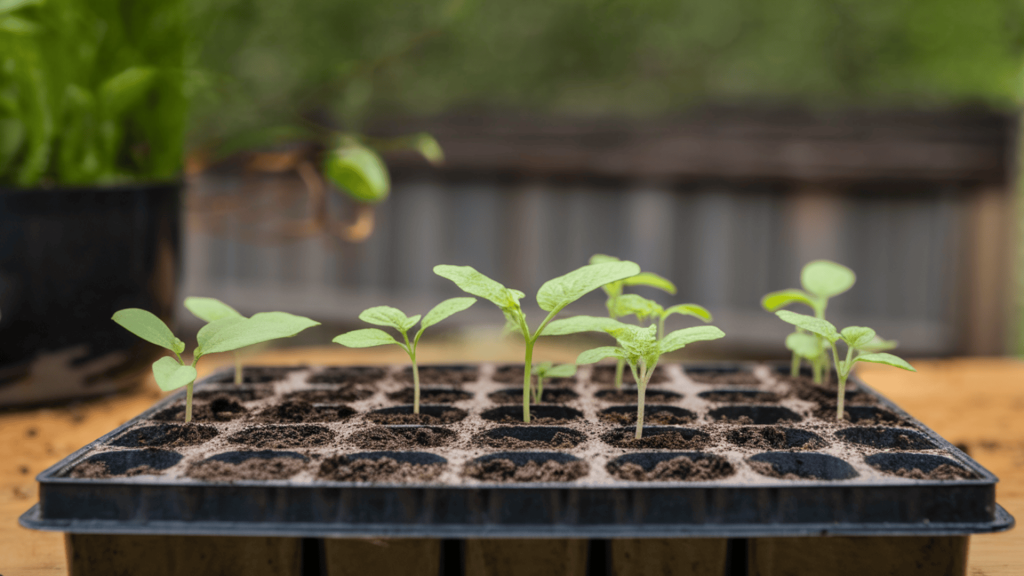
Individual cells provide optimal growing conditions for starting seeds indoors. Each cell develops an independent root systems that transplant easily without shock.
Clear covers maintain humidity during germination.
When to use: Starting vegetable and flower seeds indoors, extending growing seasons, and ensuring higher germination rates than direct sowing.
34. Dibber/Dibble
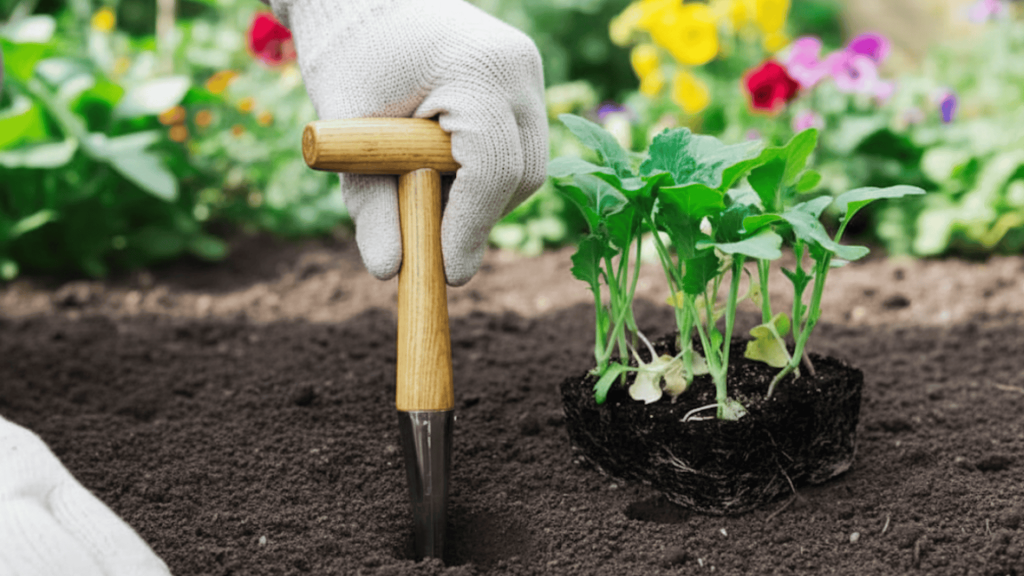
A pointed tool that creates uniform holes for seeds and small bulbs at precise depths.
The consistent hole size ensures proper spacing and planting depth for optimal germination. Some models include depth markings for accuracy.
When to use:Planting seeds in prepared beds, setting out bulbs, transplanting seedlings, and creating uniform plant spacing.
35. Bulb Planter
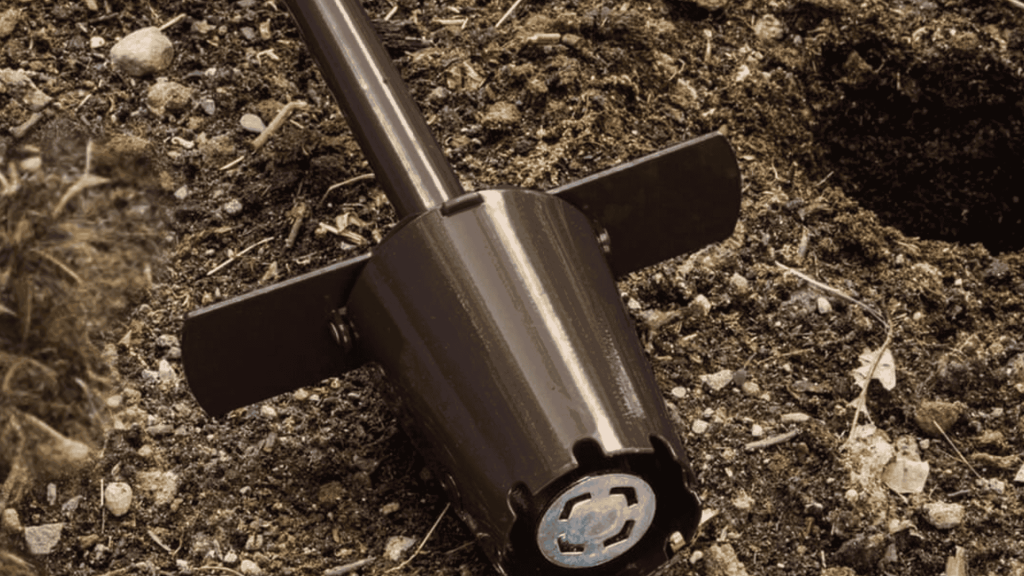
Cylindrical tool that removes the exact amount of soil needed for bulb planting, then replaces it after bulb placement.
The measuring marks ensure proper planting depth for different bulb sizes. Speeds up fall bulb planting considerably.
When to use:Fall bulb planting, creating naturalized bulb areas, planting in established lawn areas, and large-scale bulb installations.
36. Greenhouse Tools
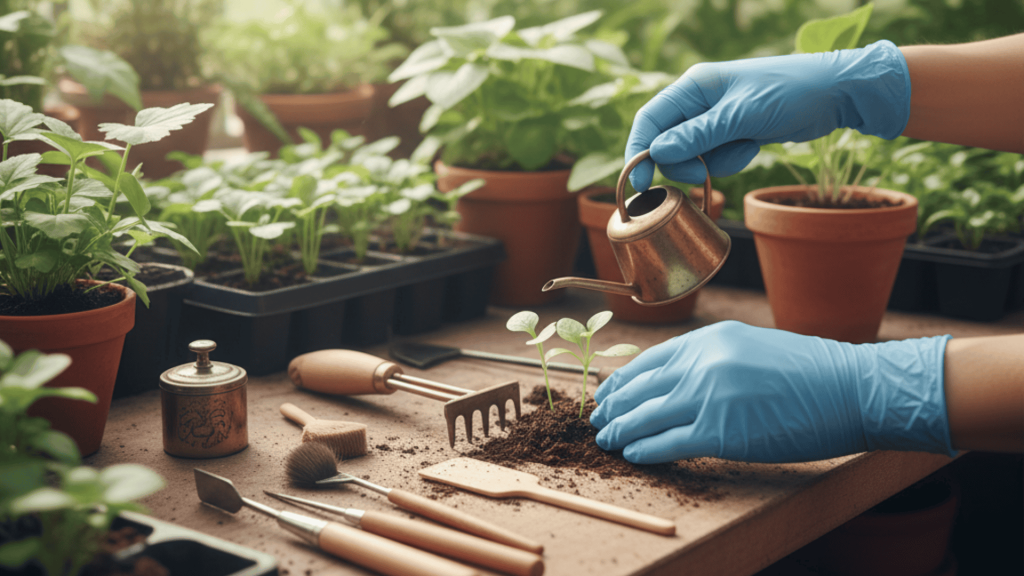
Specialized miniature tools designed for detailed work in confined spaces with delicate plants.
Include small rakes, paddles, brushes, and measuring devices. The precise size allows careful work without plant damage.
When to use: Propagating cuttings, transplanting seedlings, maintaining houseplants, and performing detailed greenhouse management tasks.
37. Propagation Dome
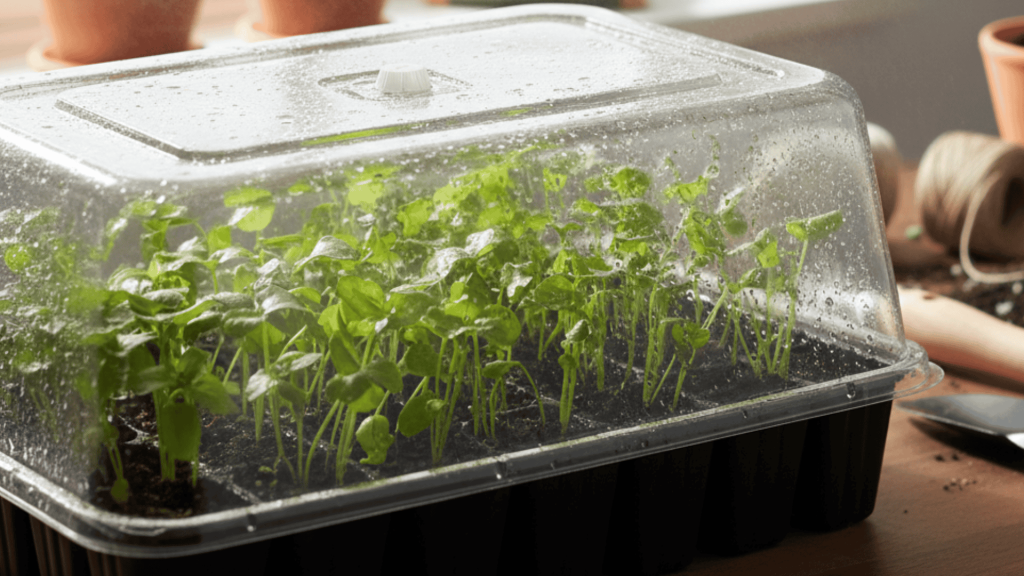
Clear plastic cover that creates controlled humidity and temperature conditions for rooting cuttings and germinating seeds.
Ventilation controls prevent overheating while maintaining optimal moisture levels.
When to use:Starting difficult seeds, rooting plant cuttings, protecting young seedlings, and creating optimal growing conditions.
38. Garden Kneeler
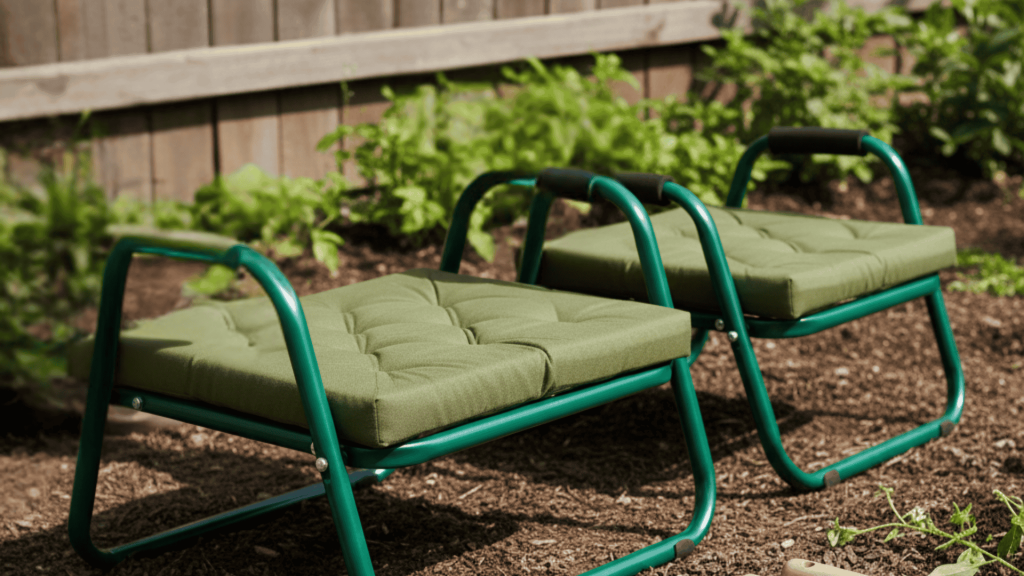
Cushioned support that protects knees during ground-level gardening tasks while reducing back strain.
Many models are converted into seats for higher work. Handles on the sides assist with getting up and down.
When to use:Weeding, planting, harvesting low crops, and any extended ground-level garden work.
39. Plant Stakes & Ties
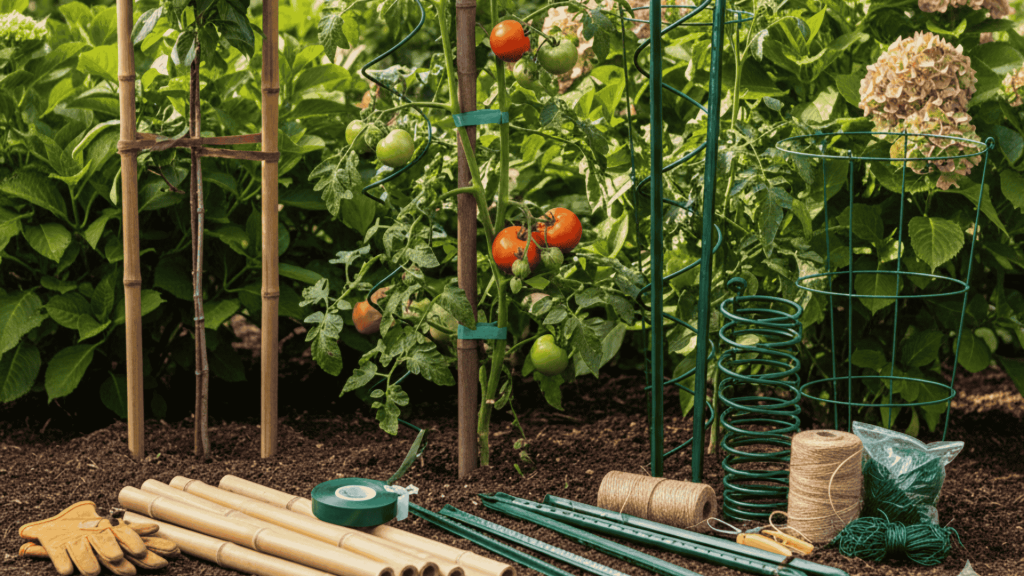
Support systems that prevent wind damage and encourage proper plant growth.
Various materials and sizes accommodate different plants from tomatoes to young trees. Soft ties prevent stem damage as plants grow.
When to use: Supporting tomatoes and peppers, staking newly planted trees, training climbing plants, and preventing storm damage.
40. Trellis
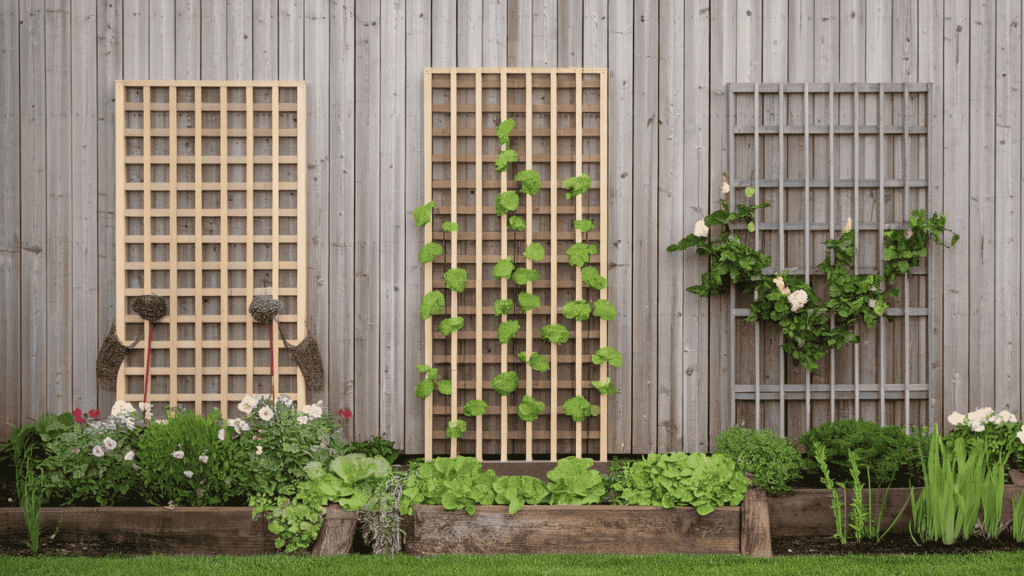
Vertical support structure that maximizes growing space while improving air circulation around climbing plants.
Various designs suit different plant types and garden styles. Proper installation supports heavy fruiting vines safely.
When to use:Growing beans and peas, training climbing roses, supporting grape vines, and creating vertical garden features.
41. Row Covers
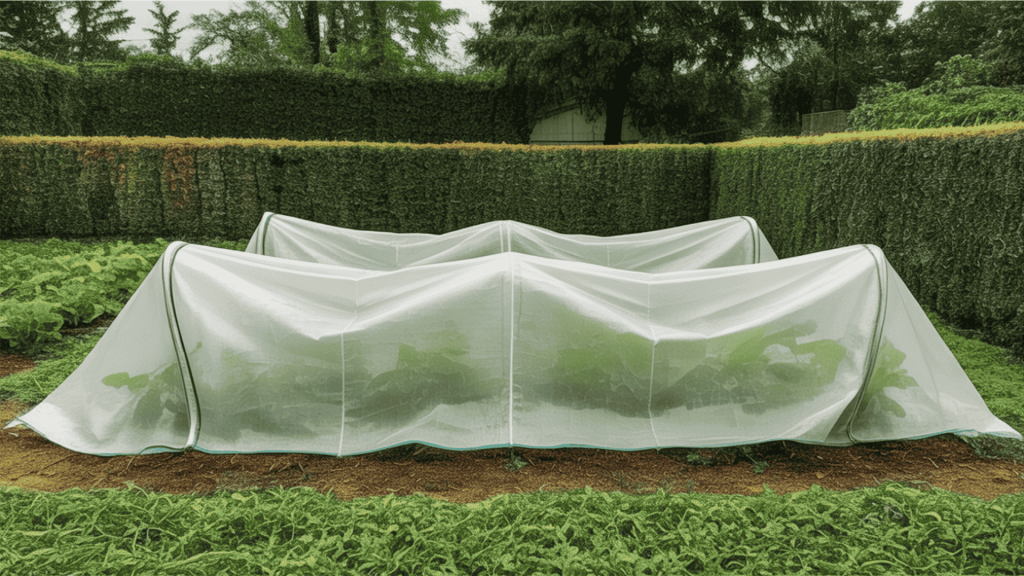
Lightweight fabric that protects crops while allowing light, air, and water penetration.
Extends growing seasons by protecting from frost and insects. Various weights provide different levels of protection.
When to use: Frost protection, insect exclusion, extending harvest seasons, and protecting young transplants from harsh weather.
42. Tool Belt/Apron
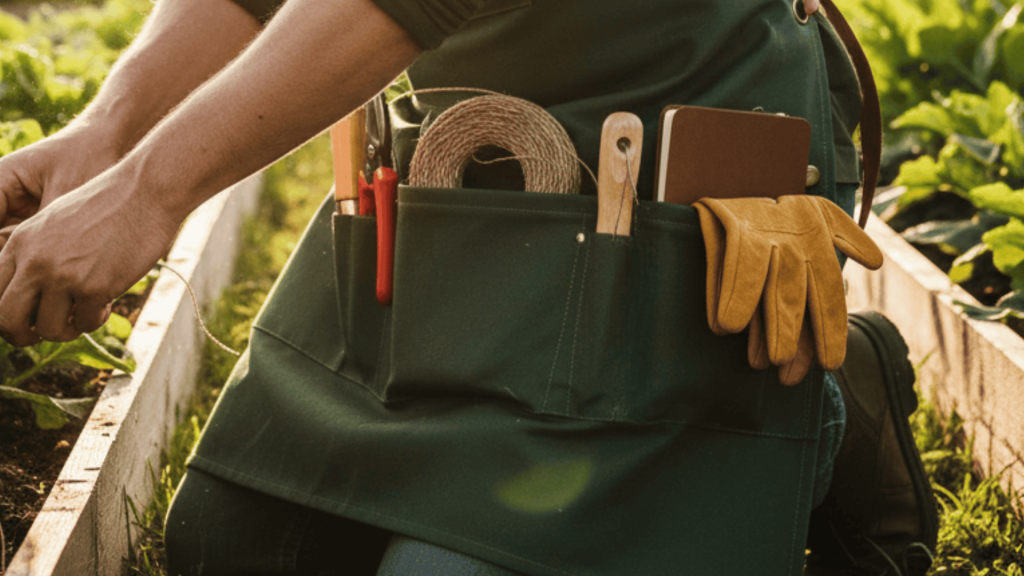
Organized storage that keeps frequently used tools within easy reach while working. Multiple pockets accommodate different tool sizes and shapes. Reduces time spent walking back to tool storage.
When to use:During extended gardening sessions, when working far from tool storage, and for tasks requiring multiple small tools.
43. Soil Tester Kit
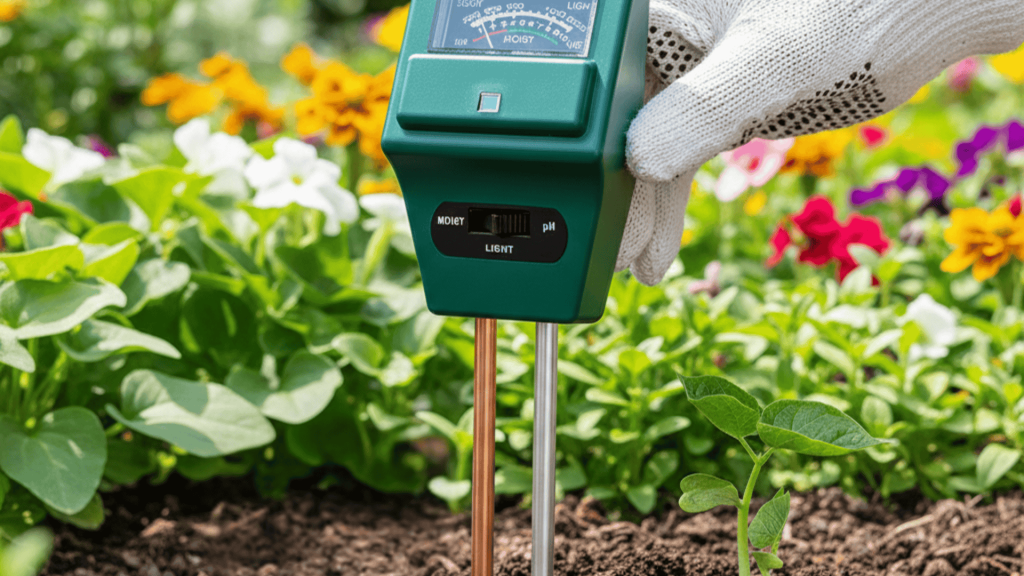
Testing equipment that measures pH, nutrients, and other soil conditions essential for plant health.
Digital or chemical test methods provide accurate readings for proper soil management. Regular testing prevents nutrient problems.
When to use: Before planting new gardens, diagnosing plant problems, planning fertilizer applications, and maintaining optimal growing conditions.
44. Irrigation Timer
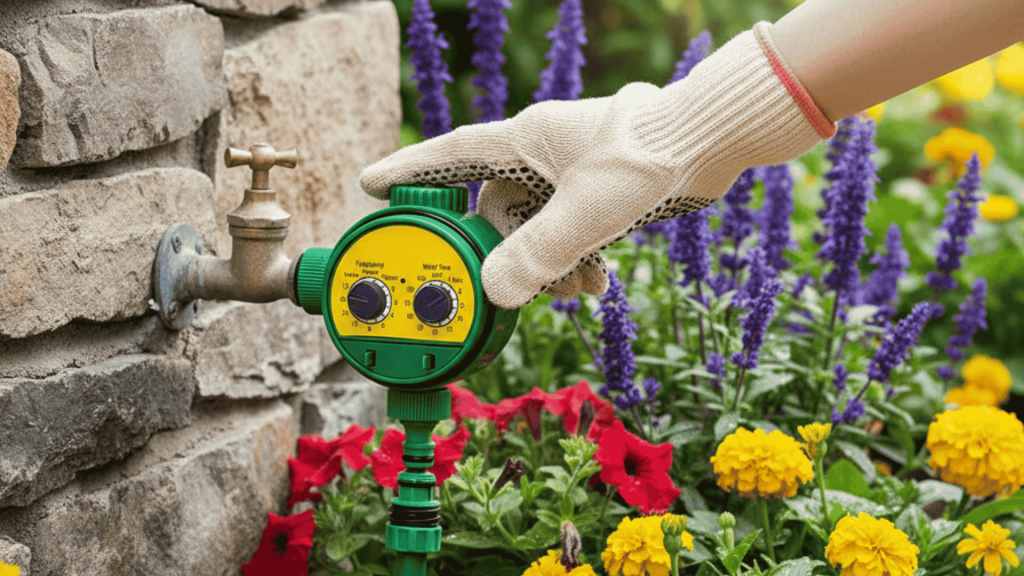
An automated control system that maintains consistent watering schedules without daily attention. Multiple zone programming accommodates different plant water needs. Weather sensors prevent watering during rain.
When to use: Vacation watering, maintaining consistent soil moisture, reducing water waste, and automating large garden irrigation.
45. Electric Trimmer
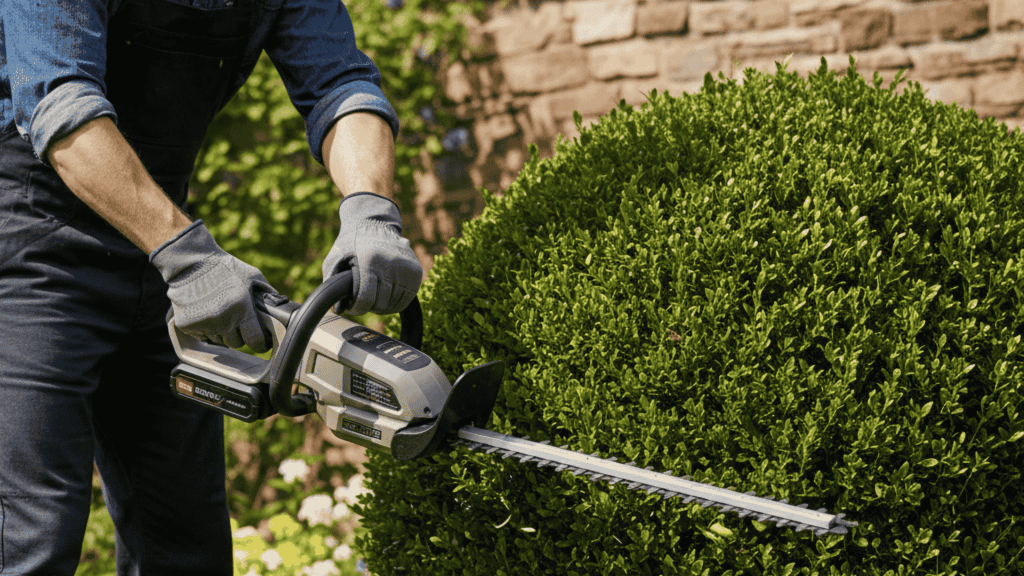
A powered cutting tool that shapes hedges and edges lawns with precision and minimal physical effort.
Cordless models offer mobility, while corded versions provide unlimited runtime. Various blade lengths are available to suit different cutting needs.
When to use:Shaping formal hedges, edging large lawn areas, maintaining topiary shapes, and handling heavy trimming jobs efficiently.
How to Choose the Right Gardening Tools?
Selecting the right gardening tools depends on three key factors: your garden size, soil type, and the plants you grow.
Small container gardens need compact hand tools, while large plots require full-sized equipment, and clay soil demands stronger tools than sandy soil.
Choose stainless steel for its resistance to rust and low maintenance, or carbon steel for sharper cutting edges that require more care.
Most importantly, prioritize ergonomic designs with comfortable grips and a proper weight distribution.
Tools that fit your hands well prevent fatigue and injury, making garden work more enjoyable. Create a shortlist of garden tools that match your space and tasks, then buy only what you’ll use often.
The Bottom Line
Having the right gardening tools converts your outdoor space from a source of frustration into a place of joy and accomplishment.
These essential tools cover every gardening need, but you don’t need them all at once. Start with basics like trowels, pruners, and gloves, then expand based on your garden’s specific requirements.
Quality tools are investments that pay dividends through healthier plants, easier maintenance, and more enjoyable gardening sessions.
Choose ergonomic designs, maintain them properly, and they’ll serve you for decades of successful growing seasons.
Ready to build your perfect tool collection? Share your favorite gardening tool in the comments below. We’d love to hear which ones have contributed to your garden’s success!
